Posted by Elena del Valle on April 9, 2010

Mexican Migration and the U.S. Economic Crisis
In the past couple of years, traffic of undocumented immigrants across the Mexico United States border has declined (see Fewer Mexican immigrants arriving, similar number returning home). Thirty-five researchers participating in the Mexican Migration Field Research and Training Program (MMFRP) based in the Center for Comparative Immigration Studies at the University of California, San Diego, and in partnership with Mexican institutions, contributed a summary of their findings on recent migration from Mexico to the United States. Their work, edited by Wayne A. Cornelius, David Fitzgerald, Pedro Lewin Fischer and Leah Muse-Orlinoff, was published this year as a book titled Mexican Migration and the U.S. Economic Crisis A Transnational Perspective (Center for Comparative Immigration Studies, $29.50).
The researchers set out to better understand how economic shocks affect populations movements, specifically those across the Mexico to United States border. They were curious to know how people were managing in places that provided or received immigrants; how individuals were making decision about migrating, staying at home or staying in the United States; and the importance of U.S. immigration enforcement at the border and within the United States in discouraging immigration and encouraging the settling of immigrants in the United States.
The 269-page softcover book is divided into 10 chapters: Introduction; Coping with La Crisis; Double Jeopardy: How U.S. Enforcement Policies Shape Tunkaseño Migration; Economic Crisis vs. Border Enforcement: What Matters Most to Prospective Migrants?; Inhabiting Two Worlds: Tunkaseños in the Transnational Labor Market; Leaving to Learn or Learning to Leave: Education in Tunkás; Values in Conflict: Youth in A Culture of Migration; The Family Dynamics of Tunkaseño Migration; Sweet Dreams and Bitter Realities: Nutrition and Health Care in Tunkás and the United States; and Reshaping Community Participation: Tunkaseños in a Binational Context.

Wayne A. Cornelius, director emeritus, Center for Comparative Immigration Studies (CCIS)
Cornelius is director emeritus, Center for Comparative Immigration Studies (CCIS), University of California-San Diego as well as Distinguished Professor of Political Science. Fitzgerald, associated director, CCIS is author of A Nation of Emigrants: How Mexico Manages Its Migration. Lewin Fischer is senior researcher at the Instituto Nacional de Antropologia e Historia’s Centro Yucatán. Leah Muse-Orlinoff is a Ph.D. candidate in sociology at the University of California, San Diego.

Click here to buy Mexican Migration and the U.S. Economic Crisis
Comments:
Filed Under: Books
Posted by Elena del Valle on April 2, 2010

The Academia Norteamericana de la Lengua Española (North American Academy of the Spanish Language) wants Spanish speakers in North America to maintain good Spanish language standards. Toward that goal the New York based nonprofit organization published, Hablando bien se entiende la gente consejos idiomáticos de la Academia Norteamericana de la Lengua Española (Santillana USA Publishing Company, $14.99), a 188-page softcover book with Spanish language tips and advice.
“Hablando bien se entiende la gente has been very well received. I think that a plus of the book is its tone. We tried to avoid a professorial, academic tone, in favor of a lighter approach,” said Gerardo Piña-Rosales, president of ANLE, by email. “ANLE does not condemn any variety of Spanish spoken in the U.S.; we merely wish to remind people that, like any other language, Spanish has its own rules, and they should be followed. An additional problem is the influence of English on Spanish.”
The book, published in Spanish this year, was edited by Piña-Rosales, Jorge I. Covarrubias, Joaquín Segura who are members of the organization’s board of directors; and Daniel Fernández. It includes 45 illustrations by Héctor Cuenca. Eight men: Joaquín Badajoz, Emilio Bernal Labrada, Antonio Culebras, Fernando A. Navarro, Antonio Pamies, Luis Pérez Botero, Luis Ríos, and Mordecai Rubín; and one woman, Vanessa Lago Barros are listed as contributors.
The book is divided into the following six sections: Las apariencias engañan, Las cosas claras y el chocolate espeso, A nadie le viene mal aprender a conjugar verbos como el verbo amar, ¡Aplique bien las reglas de la gramática!, ¡Escríbalo y pronunciélo bien!, y ¡Conozca su idioma!
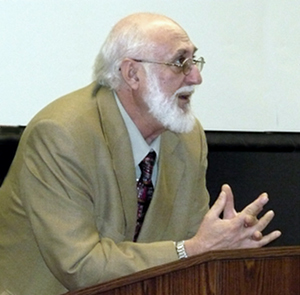
Gerardo Piña-Rosales, president, ANLE
“Our goal is not to police language usage but to help language users use Spanish so that it can be understood by all our Spanish-speakers,” said Piña-Rosales in a press release. “We hope that these ‘language capsules’ will help people who have doubts and want to use Spanish correctly. No one can dictate how people speak, but we can help those who write or work in communications fields use Spanish in ways that reflect universal usage.”
Founded in 1973, the Academia Norteamericana de la Lengua Española (ANLE) is the youngest of 22 national academies that make up the Asociación de Academias de la Lengua Española, an association of Spanish language academies across international borders.

Click here to buy Hablando (bien) se entiende la gente
Comments:
Filed Under: Books
Posted by Elena del Valle on March 26, 2010

How to Sell Your Privately Owned Company A Basic Guide for Independent Business Owners
Photos: ERV Productions, Inc.
In How to Sell Your Privately Owned Company A Basic Guide for Independent Business Owners (ERV Productions, ) Eric R. Voth and six other businessmen share how-to ideas for business owners who want to sell their companies. Voth became involved as a business transaction consultant when he sold his own business in 1993. The authors first look at the types of issues a company owner should take into account before deciding to sell his or her business.
They also examine the steps to take to ensure the business is ready to sell, finding help selling the business, determining a sales prices, preparing a plan to sell the company, finding a buyer, making a good sale, and finalizing the sale and moving on.
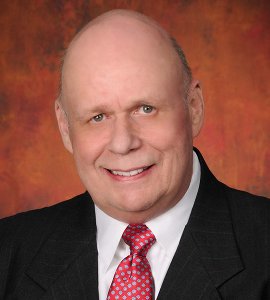
Author Eric R. Voth
In addition to Voth, the book lists profiles for two of the contributing authors: Andrew Robertson, CBI, a certified business intermediary based in California; and George Siercho, an accredited business coach based in New Jersey. The other four contributing authors are Kerney Laday, Doug Ortega and David Mahmood of Dallas, Texas; and Scott D. Mashuda of Pittsburg, Pennsylvania.
The 196-page softcover book is divided into eleven chapters: Making the Decision to Sell Your Business, Getting the Right Help, Putting a Price Tag on Your Business, Finding the Right Buyer for Your Business, Making the Right Deal, Successfully Closing the Sale – and the Door, In Conclusion, Glossary of Terminology, Internet Resources and Words of Caution, and Profiles of Contributing Writers.
According to promotional materials, Voth is a serial entrepreneur and investor who also provides matchmaking services to business sellers to merger and acquisition middlemen, investment bankers and business brokers. He is co-author with Ron Myers of The New Owner: Making the Transition from Employee to Employer.

Click here to buy How to Sell Your Privately Owned Company
Comments:
Filed Under: Books
Posted by Elena del Valle on March 12, 2010

Guerrilla Marketing Goes Green
Jay Conrad Levinson, known for his 60 Guerrilla Marketing books, and Shel Horowitz, an environmental activist and marketer for more than 30 years, teamed up to write Guerrilla Marketing Goes Green Winning Strategies to Improve Your Profits and Your Plant ( Wiley, $21.95), a book about effective marketing with an environmental emphasis published this year. The book includes a Foreword by Stephen M.R. Covey, author, The Speed of Trust.
The 236-page softcover book, based heavily on Horowtiz’ Principled Profit: Marketing That Puts People First, is divided into three parts: The Way of the Golden Rule, The New Marketing Mindset, and Hands-On with Cooperative People Centered Marketing; discussed in 21 chapters. The authors start from the perspective that being environmentally friendly is what everyone seeks to do.
They promise to explain how readers can increase profits and lower costs by emphasizing ecologically sensitive and ethical policies; convert customers, suppliers and competitors into supporters; make business acquaintances joint-venture partners; and take advantage of social and traditional media to boost revenues and decrease advertising expenses.
Conrad Levinson has taught guerrilla marketing for ten years at the extension division of the University of California in Berkley. Prior to that he was senior vice-president at J. Walter Thompson, and creative director at Leo Burnett Advertising and in Europe.
Horowitz describes himself as an ethical and green marketing expert, book shepherd, writer, international speaker, consultant, community organizer, and frugalist. He is the author of the e-book, Painless Green: 111 Tips to Help the Environment, Lower Your Carbon Footprint, Cut Your Budget, and Improve Your Quality of Life-With No Negative Impact on Your Lifestyle.

Click here to buy Guerrilla Marketing Goes Green
Comments:
Filed Under: Books
Posted by Elena del Valle on March 5, 2010

We Are Americans
William Perez, Ph.D., professor of education at Claremont Graduate University and an applied developmental psychologist, began interviewing undocumented students in 2006 to better understand their experiences growing up in the United States. To his surprise these students, part of a larger group of 3.1 million children and young adults whose immigration status in the country is illegal, exhibited a high percentage of civic involvement. He shared his findings and portions of the interviews with 16 undocumented students as well as four formerly undocumented students in a newly published book, We Are Americans Undocumented Students Pursuing the American Dream (Stylus Publishing, $22.50).
The 161-page book, published in 2009, is divided into five parts featuring the stories of high school, community college, and university students as well as college graduates, college graduates who were previously undocumented and a conclusion. He explains in the Conclusion that while 65,000 undocumented students graduate from high school in the United States every year, only one in five of these students is able to overcome the overwhelming odds to continue on to college.
He believes these undocumented students and their families are members of American society and should be granted legal status; that U.S.-born citizens have nothing to fear from these marginalized individuals and others who like them are impoverished in our nation. He advocates for the legal incorporation of undocumented youths and their families, indicating that for him it is a matter of “dignity and fundamental human rights.”
The book includes a Foreword by Daniel G. Solorzano, professor, Social Science and Comparative Education at the Graduate School of Education and Information Studies of the University of California, Los Angeles in which he sides with Perez: “Professor Perez’s research provides persuasive evidence that the talent we lose when we exclude undocumented students is a devastating loss to the United States…”

Click here to buy We Are Americans
Comments:
Filed Under: Books
Posted by Elena del Valle on February 26, 2010
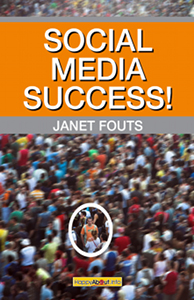
Social Media Success e-book cover
Photos: Janet Fouts
Janet Fouts, an educator, speaker and social media coach at Tatu Digital Media, dedicated time over six months to write her first non fiction e-book, Social Media Success (Happy About, $14.95). Her intention was to answer many questions from clients and blogs and share suggestions on how readers can take advantage of social media for their business needs. The 145-page e-book, also available as a 162-page print book ($19.95), outlines the basics of online social media issues. It includes a Foreword by Aaron Strout, chief marketing officer, Powered Inc.
“I wrote this book to pull together answers to the questions from my clients and on the blogs all in one place. I wanted to write a book that goes beyond telling people how they need to use social media and give them real actionable information they can use in their business,” said Fouts when asked why she wrote the book.
The e-book is divided into 23 chapters that discuss social media concepts, videos, blogging, etiquette, groups, nonprofits, measurement and some of the better known sites such as Twitter, Facebook, Flickr, FriendFeed, and LinkedIn. Some of the chapters such as Flickr, Measurement and Efficiency Matters are short, (one or two pages in length), while others like Set Some Rules have a more conventional length.
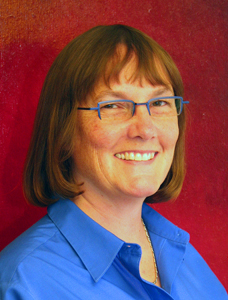
Author Janet Fouts
One of the nuggets of wisdom is in Strout’s words: “… social media is a slow waltz, not a frenetic boogie and it takes time for it to work.” While social media may offer a forum to accomplish amazing things, as Fouts says in the Introduction, it seems that to be successful and reap the benefits of social media outreach users must be diligent and patient. She drives home the point that social media is about developing relationships, having real conversations and establishing trust.
For social beings social media may be an ideal environment to connect with friends, followers and even customers. Through the vast networks of users social media can help an individual, organization or company promote products or services to people the initial user may have never even met. Fouts admiration for the tools is evident when she says: “It can open your eyes to the richness of human relationships and even find you a mate.”
As a senior partner at her company Fouts has worked with the online community for 13 years and with small businesses to develop their online presence. She dedicates some of her time to helping individuals and corporations understand how to use social media tools effectively and conducting in-house workshops and virtual training sessions on social media tools and strategy.

Click here to buy Social Media Success!
Comments:
Filed Under: Books
Posted by Elena del Valle on February 19, 2010

Diabetes? No Problema The Latino’s Guide to Living Well with Diabetes
Photos: Sheri R. Colberg, Leonel Villa-Caballero
The average newborn today has a 30 percent chance of becoming diabetic. A Hispanic newborn has nearly a 50 percent chance of developing diabetes. With these daunting statistics how are families able to deal with diabetes and maintain a good quality of life? Doctors and specialists believe it’s possible for diabetics to overcome the odds and live a healthy and happy life.
Sheri R. Colberg, Ph.D. and Leonel Villa-Caballero, M.D., Ph.D. share the benefits of years of experience and studies in a book published in 2009 targeting Latinos, in English, on the oft discussed topic of diabetes. In Diabetes? No Problema The Latino’s Guide to Living Well with Diabetes (Da Capo Press, $15.95), a 270-page softcover book they explore the medical condition as it relates to Latinos in the United States.
Among the 24 million people with diabetes in 2007 (one quarter of which were unaware of their condition), they believe Latinos are subject to special barriers including cultural issues relating to food consumption that can and have been overcome by many people. How? Lifestyle choices regarding diet, exercise and body weight have been known to delay or prevent diabetes in two of three Hispanics.
In the 10-chapter book these two experts discuss the myths and realities of insulin, how dietary precautions can help lower sugar blood levels, ways to minimize stress, avoiding pitfalls, and how patients can exercise safely and effectively to conquer the threats diabetes brings.

Sheri R. Colberg, Ph.D.
Colberg, an exercise physiologist and professor of exercise science at Old Dominion University in Virginia, is a diabetes sufferer herself. She has worked as an exercise specialist at a diabetes treatment center and authored seven other books including The Diabetic Athlete, Diabetes-Free Kids, and The 7 Step Diabetes Fitness Plan.

Leonel Villa-Caballero, M.D., Ph.D
Villa-Caballero, a researcher in the Family and Preventive Medicine Department at the University of California-San Diego, has more than 17 years of experience treating patients with diabetes. The Mexico City-born physician was awarded the American Diabetes Association Cielo Award for his efforts toward improving the health of Latinos.

Click here to buy Diabetes? No Problema!
Diabetic Athlete’s Handbook
The 7 Step Diabetes Fitness Plan
Comments:
Filed Under: Books
Posted by Elena del Valle on February 12, 2010

Bridging the Diversity Divide
University administrators, educators and anyone wishing to better understand diversity have a new resource available in Bridging the Diversity Divide Globalization and Reciprocal Empowerment in Higher Education (Joseey-Bass, $29) by Edna Chun and Alvin Evans. The 144-page softcover research based book was designed as a practical guide for those wishing to develop inclusive campuses. The authors believe systematic organizational change is essential in order to achieve true inclusively universities.
Published in 2009, the book is divided into five main sections: The Changing Landscape and the Compelling Need for Diversity; Translating Principles into Practice; Mapping the Terrain for Inclusion and Bridging the Gaps; Orchestrating the Process of Cultural Change; and A Toolkit for Operational Reciprocal Empowerment. There is also an executive summary, recommendations and two appendices.
The authors recommend organizations that want to embrace inclusive principles adopt a change model based on organizational learning ideas; formally outline, in cooperation with employees and relevant groups, the diversity ideas they wish to add; allocate resources to the inclusive project accordingly; measure results; highlight success case studies; be alert to disparate treatment of minorities and monitor retention; and establish a work environment where stereotypes are dispelled.
Chun, vice president, Human Resources at Broward College in Fort Lauderdale, Florida, has more than 20 years of human resources experience in public research universities in California, Oregon and Ohio. Evans is associate vice president, Human Resources and Kent State University. He has more than 20 years of experience in public sector human resources management and organizational development.

Click here to buy Bridging the Diversity Divide
Comments:
Filed Under: Books
Posted by Elena del Valle on January 29, 2010

Winning Job Interviews book cover
Photos: Career Press, Paul Powers, Ph.D.
In Winning Job Interviews (Career Press, $12,99), a 218-page softcover book, Paul Powers, Ph.D. offers readers strategies and techniques to help them get the job interview they want. He discusses how readers can overcome difficult obstacles, be prepared to answer interview questions, increase the quantity and quality of job offers, avoid social networking mistakes, secure their jobs and be ready in case of trouble.
The book, published this year, is divided into nine chapters: Why Job Hunting Sucks; How To Get More and Better Interviews; You Are in Control; Building Your Winning Interview Plan; How To Have Glowing Job References; How To Close the Deal and Get the Job Offer; Turning the Offer Into a Job You Love; Glitches, Potholes, Calamities and Idiots; and The Winning Job Interview Toolkit.

Paul Powers, Ph.D., author, Winning Job Interviews
Powers, a licensed psychologist and former chair of the Massachusetts Board of Psychologists, is a graduate of the University of Massachusetts at Amherst. He is a speaker and executive coach dedicated to helping other achieve a more rewarding career, a more productive organization and a more balanced, satisfying life.” He divides his time between Massachusetts and Florida.

Click here to buy Winning Job Interviews
Comments:
Filed Under: Books
Posted by Elena del Valle on January 22, 2010
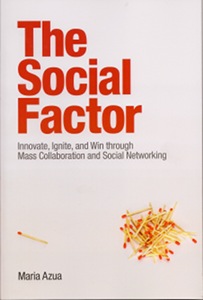
The Social Factor book cover
Maria Azua, an IBM executive, outlines the benefits of social media for business in The Social Factor Innovate, Ignite, and Win Through Mass Collaboration and Social Networking (IBM Press, $29.99), a 248-page paperback book published in 2010. Her goal in writing the book was to provide strategic and tactical insights for business executives based on her and her colleagues’ experience and case studies within her company, and help readers avoid social networking mistakes.
To complete the project which took four years of hands on investigation and analysis she relied on the contribution and input of 10 colleagues: Boas Betzler, Bill Bodin, Christopher Douglass, Brian Goodman, Reed Mullen, Carl Burnett, Dave Newbold, Mahesh Parakdar, Gina Poole, Michael Roche, and Laurisa Rodriguez, the only contributor that was not from IBM.
She and her colleagues at IBM believe three forces are driving social and workplace interactions: Information overload from the Information Age, standardization of technology, and the availability of low cost two-way communication online.
The book is divided into 12 chapters: Dawn of the Social Age, Social Age Organizations, Wikis: Bringing the Crowds to You, Blogs: Your Personal News Outlet, Tagging and Social Clouds, Cloud Computing Paradigm, Social Media and Culture, On the Shoulders of Giants, Social Brain and the Ideation Process, Social Innovation, Social Economy, and Mobile Society.
Maria Azua, vice president of Cloud Computing Enablement, IBM Enterprise Initiatives, is responsible for the technical implementation, deployment and operations of the Common Cloud Platform Living Lab share service, as well as the IBM Smart Business Development and Test on the IBM Cloud. She is also responsible for the creation of a community of independent software vendors, business partners, and technical community that fosters cloud computing IT methodologies and applications.

Click here to buy The Social Factor
Comments:
Filed Under: Books




































